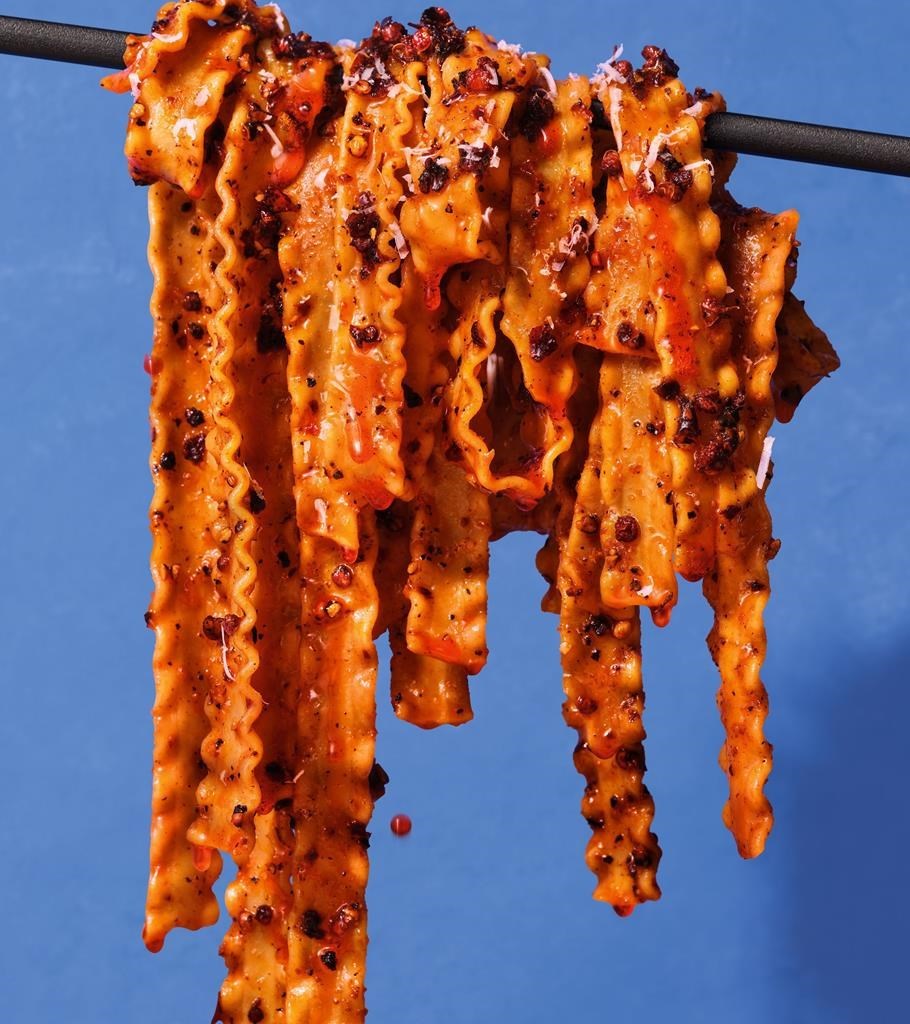NEW YORK (AP) ŌĆö Food writer and podcaster Dan Pashman made the unusual step a few years ago of creating an entirely new shape of pasta. The obvious next step? Writing a cookbook to highlight it.
Pashman's ŌĆ£Anything's PastableŌĆØ features dishes using 34 different pasta shapes, but especially features his cascatelli, a graceful, ruffled-edged curved shape that resembles a quotation mark. Time magazine declared cascatelli one of 2021ŌĆÖs best inventions.
Pashman came up with the idea of writing a pasta cookbook after he noticed that many of cascatelli's fans were sending him images of them eating it in very traditional ways. Maybe even boring ways.
ŌĆ£A huge percentage of the photos I was getting were just tomato sauce, meat sauce, mac ŌĆśnŌĆÖ cheese. Maybe a few party animals made pesto,ŌĆØ he says. ŌĆ£It just made me a little bit sad. Those are all delicious, but thereŌĆÖs just so much more.ŌĆØ
So Pashman ŌĆö a winner and Webby Award-winning podcaster behind ŌĆö got to work creating mind-bending pasta dishes, from Tortellini in Kimchi Parmesan Brodo to Gnocchi with Bacon and Sauerkraut.
CLASSIC SAUCES GET NEW TWISTS
This is not a traditional pasta sauce book by any means and Pashman even avoids making any classic marinara. Instead, there are flavors from places like India, Thailand, the Middle East, North African, Mexico, Japan and Peru.
He even makes a pizza out of fettuccine ŌĆö a pasta pizza.
ŌĆ£When I go to make a cookbook or make pasta, itŌĆÖs not my instinct to limit myself to only the classic Italian dishes that I grew up eating. ItŌĆÖs also all the other things that I love to eat,ŌĆØ he says.
Pashman dreamed up many of the dishes ŌĆö the pasta pizza came to him while he was driving ŌĆö and leaned on a half dozen recipe developers to offer their takes, suggestions and refinement.
The book is a clever mix of possibilities, like Mac ŌĆśNŌĆÖ Dal, which combines lentils and pigeon peas with cumin, coriander, turmeric, yogurt and lumache pasta. Or Linguini with Miso Clam Sauce, a saucy take on a classic. Or Tangy Labne Noodle Kugel with Persimmon Relish ŌĆö your grandmother may have to look away.
ŌĆ£On the surface, I understand that this cookbook will look to a lot of people like somewhat radical," he says. ŌĆ£But itŌĆÖs a natural extension of the coming together of different cuisines in America.ŌĆØ
Italian food doesn't stay the same either, he notes.
Despite the ŌĆ£stereotype of Italians as being sort of closed to any kind of change in tradition, the fact is that Italian pasta culture has been changing and evolving all the while,ŌĆØ he says. ŌĆ£As long as there are humans cooking in kitchens, then there will be new ideas and things will change and evolve.ŌĆØ
AN ANALYTICAL APPROACH
Pashman ŌĆö a deliberate and even obsessive home chef who has long analyzed everything from various salts to different cheese-grating methods ŌĆö attacked the book in the same way.
ŌĆ£I approach food very analytically. I come from a long line of lawyers, and itŌĆÖs always kind of my instinct to break a dish of food down to its component parts,ŌĆØ he says. ŌĆ£When you start to do that, you see there are a lot of similarities across cuisines.ŌĆØ
For one dish, he started with bolognese, Italy's great meat sauce. Then he thought about other ground meat dishes. He remembered larb, a Laos meat salad. He reached out to recipe developer and the two kept refining until they came up with a ground meat sauce for his cascatelli with mint, lemon juice, chili and fish sauce.
Park, the author of the cookbook ŌĆ£Chili Crisp,ŌĆØ contributed to five recipes in Pashman's book, and said the process ŌĆ£allowed me to push the boundaries of what pasta can be.ŌĆØ
ŌĆ£Food is a really safe and exciting playground where you can be free and combine so many different inspirations into one amazing dish. Dan really allowed me to go full force with my wild, exciting ideas,ŌĆØ he says.
CHOOSE WHAT FEELS GOOD
Pashman organized ŌĆ£AnythingŌĆÖs PastableŌĆØ in an intriguing way ŌĆö by mood. ŌĆ£Adventures in Texture,ŌĆØ ŌĆ£Flavor Bombs Not Belly BombsŌĆØ and ŌĆ£Thick and Hearty, Warm and ToastyŌĆØ are some of the sections. He made one for pasta salads and another for baked dishes.
ŌĆ£If you open up this book, I want you to be thinking, IŌĆÖm in the mood for this type of pasta dish, and you should be able to find the chapter thatŌĆÖs going to give you that,ŌĆØ Pashman says.
Many of the dishes are designed to showcase cascatelli, which he designed with three goals: To have a shape with forkability, toothsinkability and sauceability ŌĆö all terms he invented.
His signature paste endures as a favorite in the Pashman home. He says the family initially ate so much cascatelli that they burned out on it, but a few weeks ago returned after Dan made it with arugula pesto.
ŌĆ£Both my kids were like, ŌĆśWow, we missed cascatelli.ŌĆÖ" he says.
"So that made me feel good.ŌĆØ
___
Mark Kennedy is at
Mark Kennedy, The Associated Press




